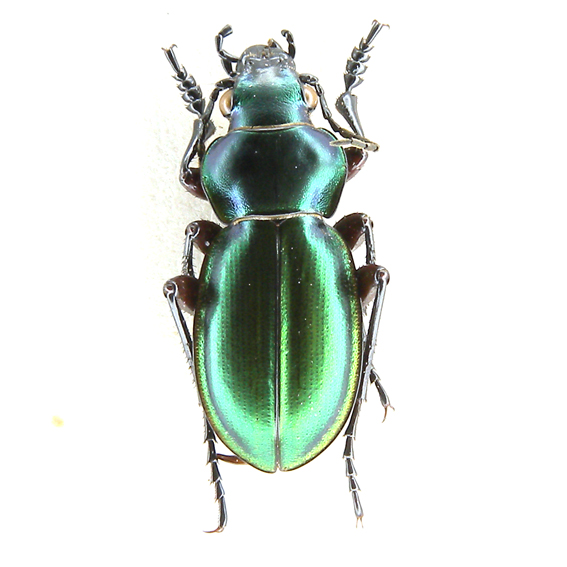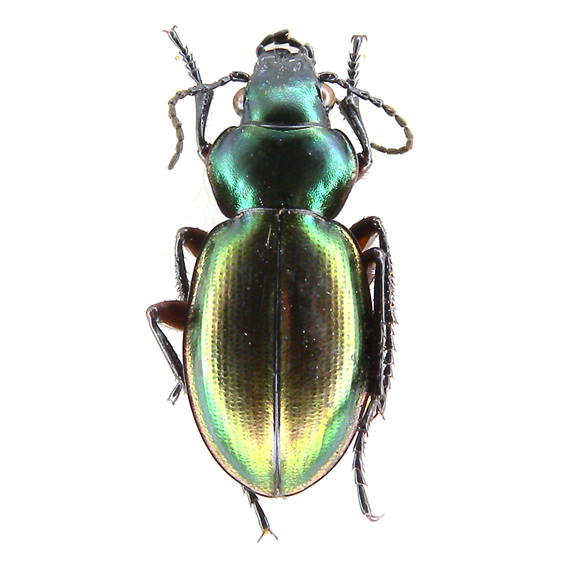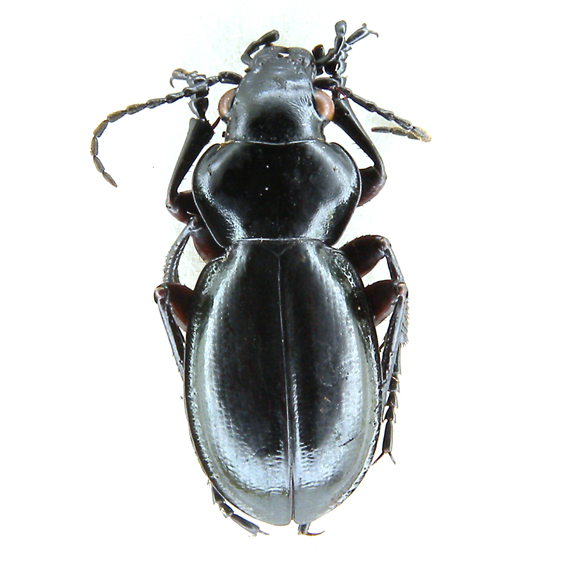Calosoma (Carabophanus) arrowi Breuning, 1928
Calosoma (Carabophanus) arrowi Breuning, 1928: 94 (type locality: Abissin); holotype ♀ in British Museum of Natural History, London [examined]
Orinodromus (Carabophanus) arrowi Jeannel, 1940: 145
Calosoma (Carabophanus) excellens Beheim & Breuning, 1943: 21 (type locality: Adis Abeba); holotype ♀ in Naturalis Biodiversity Centre, Leiden (de Boer, 2002: 48)
Carabophanus arrowi Basilewsky 1962: 33
Carabophanus arrowi var. gestroides Rougemont, 1976: 258 (from Geech Amba); original material: 1 ♂ in Musée Royal de l'Afrique Central, Tervuren
Length 13-18 mm. The species was described on a single female specimen preserved at the British Museum, which had been noted without receiving a name by Roeschke (1900a: 72). The male, later discovered in the collection of the Zoological Institute of the Russian Academy of Sciences of Saint Petersburg, was described by Basilewsky (1962: 33).
The pronotum of C. arrowi is slightly sinuate in the rear, with lobes more or less developed. The femurs are constantly red and two raised lines run parallel to the suture of elytra along its entire length. The colour of the upper body is very variable: green with golden hues, cupreous, dark green, blue-black, but arrowi is always easily identifiable because of the series of opaque black spots, aligned in correspondence with the striae of the elytra. As for C. arrowi var. gestroides characterized by the color opaque black, presumably due to cuticle wear, the name, attributed to an individual variation, is to be considered superfluous (Vigna Taglianti & Bruschi, 1988: 17).
According to Rougemont (1976: 258), Calosoma (Carabophanus) excellens must be considered a synonym of Calosoma (Carabophanus) arrowi .
C. arrowi occupies the north of the former province of Shewa, and the provinces of the Gojjam and Begemder up to Simien massif, and it partly overlaps the habitat of raffrayi in the north, and the one of antinorii in the south.
Examined specimens and literature’s data
Ethiopia. Abissin (holotype, BMNH); Begmender: between Debre Tabor and Nefas Meewcha (Rougemont, 1976: 257), Semien mts (13°23’N 38°20’E) (Rougemont, 1976: 257),Geech Amba (type var. gestroides, RMCA); Gojam: 2Km W Ambagir (10°44’N; 37°59’E), Choke Mt. (10°44’N; 37°57’E) (Rougemont, 1976: 257); Shewa: Addis Abeba (holotype C. excellens, Beheim & Breuning, 1943: 21), between Debre Birhan and Ankober 3100 m (AVT, EM, GP, SB), Chacha valley (9°48’N 39°23’E) (Rougemont, 1976: 257); Termaber Pass 3100 m (SB).
Notes: Brachhypterous, the wings are reduced to a stump. Adults are mostly nocturnal and shelter during the day under stones and tufts of grass, but some of them were found in activity even in bright sunlight. It lives in pastures,tilled fields and fallow land, between 3200 and 3400m., always in an environment characterized by high soil moisture. In Shewa region, adults were found in activity of mating and oviposition in the beginning of the first rainy period between February and April. Development from egg to adult is expected between March and June. The adults reappear at the end of the second and more important rainy period and are active from October to April, but in case of severe drought, they shelter in cells deeply buried beneath stones.
The description of first and second stage larva is found in Vigna Taglianti & Bruschi (1986: 18).
The species is named after Gilbert John Arrow (1873 - 1948) an English entomologist on the staff of the Natural History Museum in London from 1896 until 1938.
 Breuning, 1928 Ethiopia: Shewa, between Debre Birhan and Ankober 3100m, 7.IV.1985, S. Bruschi leg. |
 Breuning, 1928 Ethiopia: Shewa, between Debre Birhan and Ankober 3100m, 7.IV.1985, S. Bruschi leg. |
 Breuning, 1928 Ethiopia: Shewa, between Debre Birhan and Ankober 3100m, 7.IV.1985, S. Bruschi leg. |
 Breuning, 1928 Ethiopia: Shewa, between Debre Birhan and Ankober 3100m, 7.IV.1985, S. Bruschi leg. |